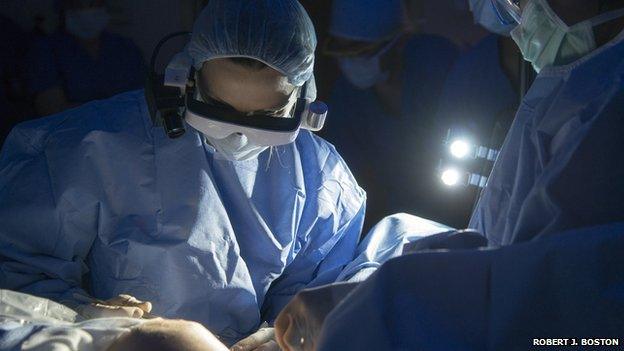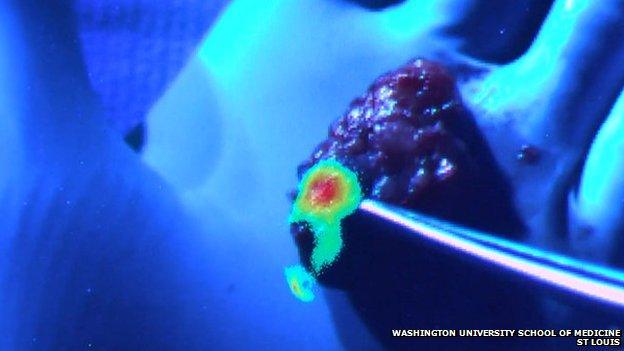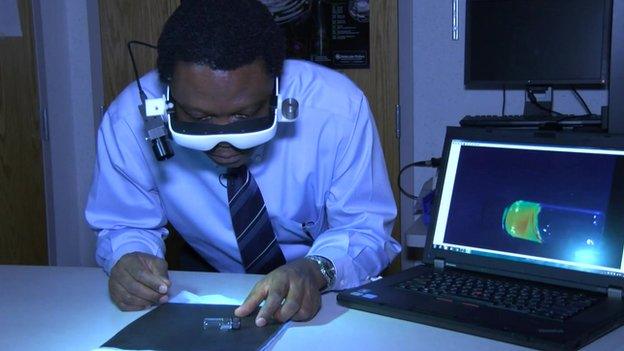Goggles help surgeons ‘see’ tumours
- Published

The newly developed goggles allow surgeons to 'see' the cancer cells they need to remove
Scientists are continually seeking new ways of targeting cancer - and the latest is high-tech goggles.
Currently doctors treating cancer have two main approaches - bombard the tumour with drugs and radiotherapy or cut it out.
The second option is very common but not always successful - because it is often also impossible to tell where the tumour ends and healthy tissue begins.
To try and combat this surgeons often remove tissue surrounding the tumour, but cancerous cells often remain, necessitating further surgery.
But a new goggle technology being developed in the US lets surgeons "see" which cells are cancerous and which are healthy, increasing the chances that they will be able remove all cancer cells in one operation.
"The technology is quite amazing - almost like having a microscope to guide your surgery in the operating room," says Dr Ryan Fields, a surgeon involved in a pilot study of the device.

The view through the goggles: cancer cells show up as glowing hotspots
'Seeing' cancer
In the study, patients are being injected with a dye before their surgery. The dye has a peptide - a small protein - attached to it that allows it to seek out and bind specifically to cancer cells.
The dyed cancer cells emit light at a wavelength that cannot be seen by the human eye, but can be detected by a sensor in the goggles worn by the surgeons.
"The sensor captures the fluorescence from the dye lodged in cancer tissue and projects the image into the surgeon's [field of] view," explained Dr Achilefu.
"This creates an augmented reality that allows the surgeons to see cancer cells glowing, providing real-time guidance during surgery.

Dr Samuel Achilefu has developed both the dye and goggle technology
It's early days but surgeons think that this technology is promising.
"It has the potential to reduce the size of operations, when safe, and guide us to take out more tissue, when required," said Dr Ryan Fields, a surgeon at Siteman Cancer Center at Barnes-Jewish Hospital.
It is estimated that up to 40% of breast cancer patients in the US, and just under 20% in the UK, require secondary surgery.
Being able to take a more strategic, precise approach to removing tumours could reduce the need for patients to undergo further stressful procedures.
Surgical precision
So far this new goggle technology has only been trialled on patients suffering from skin and breast cancer.
But Dr Achilefu is confident it can be used for different types of cancer. The dye has been shown to bind to breast, prostate, lung, colon pancreatic cancers, among others. It has even been shown to detect pre-cancerous cells.

Dr Ryan Fields has used the goggles during the pilot study in America
These goggles are bringing instant tumour imaging to the operating room. But they aren't the only technology that is helping to improve the accuracy of tumour removal.
Elsewhere, other researchers have modified a surgical knife that uses heat to cut through tissue so it can instantly analyse whether the tissue the surgeon is cutting through is cancerous or healthy.
Smoke released when the heated blade cuts through tissue is sucked into a device that 'sniffs' it, analysing whether it is cancerous or healthy - allowing the surgeons to find the edges of the tumour and remove it with greater precision.
The goggles create an augmented reality, showing cancerous cells as glowing
The true test of Dr Achilefu's goggles will be a large trial involving many hospitals.
"This type of technology certainly shows promise,' said Mr Tim Underwood, Senior Lecturer and Honorary Consultant Surgeon at University of Southampton, UK.
But he also cautions that, "All of these [new] technologies need much larger trials to prove their worth before they can be considered for routine use."